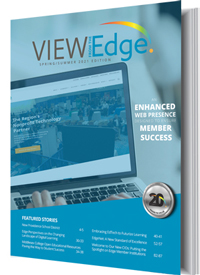Designed to create a personalized and powerful learning experience for students, Edge’s learner-centric technology solutions provide faculty, instructional designers, educational technologists, and technology support personnel with the platforms and tools needed to enhance teaching and learning. Over the past year, digital learning and remote education became an even larger part of the norm, driving educational technology to keep pace with a rising need for innovative and versatile solutions. As unique challenges and opportunities unfolded, member institutions tapped into Edge’s solution suite in new and powerful ways. Edge’s existing partnership with Zoom allowed many institutions to take advantage of this solution with Edge expertise to support them. Moving forward, institutions can leverage Edge’s knowledge to transform from users of educational technologies like Zoom to innovators in the EdTech arena.
Edge’s Educational and Emerging Technology Practice Group convenes around the multiple facets of technology and pedagogy and provides a platform for the member community to share their insight, pain points, and suggestions. In addition, Edge shares expertise and information on different topics during each session and offers a place for members to collaborate. Setting competition aside, institutions across the community are sharing ideas, best practices, and personal experiences, all with a common goal of improving student success. Edge is dedicated to bringing all these pieces together and ensuring organizations have the tools they need to achieve eLearning success.
The eLearning Big Picture
Edge’s Digital Learning solutions empower member institutions to provide anytime, anywhere teaching and learning and create flexible digital learning environments that can continue to evolve in the years ahead. Schools that didn’t have an expansive infrastructure for asynchronous instruction during the pandemic were forced to quickly move to synchronous online instruction, with many instructors teaching through Zoom, WebEx, or similar tools for the first time. As schools return to normal, the question arises; will these delivery modes continue to be effective choices?
While COVID forced many institutions to quickly create a digital space for remote education, the important focus now lies in how to further develop and enhance these digital environments to help an organization accomplish future educational and business goals. Since face-to-face instruction going forward will no longer exist without a digital component, institutions must take a closer look at how to create long-term strategies for instructional design, Learning Management Systems (LMS), accessibility, collaboration and communication capabilities, and seamlessly integrating EdTech solutions. With these goals in mind, Edge provides solutions for digital content needs all in one place and can augment an institution’s technology team to help streamline the digital transformation process.
“Setting competition aside, institutions across the community are sharing ideas, best practices, and personal experiences, all with a common goal of improving student success. Edge is dedicated to bringing all these pieces together and ensuring organizations have the tools they need to achieve eLearning success.”
– Josh Gaul

Sharing EdTech Best Practices
During a time when community engagement and collaboration were essential, Edge created EdTech Table sessions to allow members a way to connect with others in the community and discuss the hot topics in education technology from their organizations. This opportunity also allows Edge to ensure the solutions and services they provide to member organizations are meeting their specific needs and providing the most benefits to every institution. Each discussion features subjects that are relevant to instructional designers, instructional technologists, faculty/instructors, and directors of online programming. For instance, a recent session explored creating engaging course content and how to better balance day-to-day EdTech needs with long term strategic planning. Another recent session discussed the steps educational technology professionals are taking to ensure leadership recognizes the importance of continuing investment in their services, even as the pandemic ends.
EdTech tools can help institutions create more inclusive and engaging educational experiences and allow today’s schools to advance into new areas of learning and instruction. Technology, both inside and outside the classroom, is here to stay and understanding the benefits of EdTech will be important to helping institutions boost the quality of education and meet the evolving needs of both teachers and students. Going forward, EdTech Table sessions will continue to help institutions explore industry trends and the best practices of their peers, while providing a springboard for innovative ideas that can help create a more vibrant and advanced digital learning community.
Explore and discover Edge’s Digital Learning solutions via njedge.net/solutions-overview/educational-technologies/ and stay tuned to the EdgeEvents page for upcoming events dedicated to supporting this thriving community.



